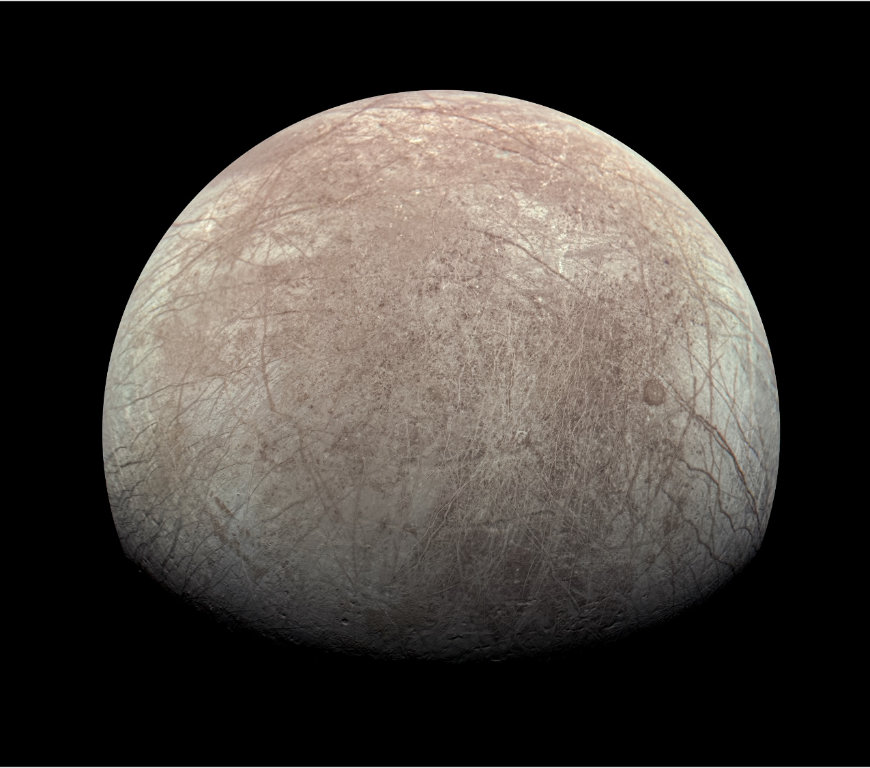Jupiter probe measures oxygen production on Europa
Beneath the ice cap of Jupiter's moon Europa, there is likely a huge ocean of salt water. It is now possible to use measurements from a NASA probe flyby Juno The amount of oxygen produced on the Moon can be extracted by intense particle bombardment. This is much lower than previously expected.
|
Jupiter's moon Europa in a view created from data from NASA's Juno probe as it flyby on September 29, 2022. [Groansicht] |
With a diameter of 3,100 km at the equator, Europa is the fourth largest of Jupiter's 95 known moons and the smallest of the four Galilean moons. Research suggests that a vast saltwater ocean lies hidden beneath its icy crust. It is still unclear whether conditions suitable for life exist below the surface. A team of researchers from the NASA mission Juno I now calculate that oxygen production in Europe is much lower than previous studies had predicted. The results were obtained by measuring the release of hydrogen gases on the Moon's surface using data from the Moon Jovian auroral distributions experiment (Jade) by Juno had won. Until now, the composition of Europe's atmosphere has not been measured directly.
Measurements confirm that the atmosphere consists mainly of oxygen and hydrogen. In the study now published, the authors estimate the amount of oxygen produced at about twelve kilograms per second. Previous estimates ranged to more than a thousand kilograms per second. The researchers believe that some of the oxygen produced in this way could reach the lunar subsurface ocean and become a potential source of metabolic energy.
In its orbit, Europa is located in the middle of the gas giant's radiation belt. Charged or ionized particles from Jupiter bombard the icy surface, splitting the water molecules in half. This creates oxygen that can reach the moon's ocean. Although continuous bombardment is responsible for the production of oxygen from water molecules, it also contributes to its loss through water erosion.
“Europe is like a snowball that slowly loses its water in a flowing stream. The ionized particles then flow around the planet through Jupiter’s exceptional magnetic field,” explains Dr. James Szalay of
Princeton University. “When these ionized particles hit Europa, they break down the water ice on the surface molecule by molecule, producing hydrogen and oxygen. In a sense, the entire ice shell is constantly being eroded by collisions with charged particles.”
like Juno Flying past Europa at a distance of 354 kilometers on September 29, 2022, the JADE instrument identified and measured hydrogen and oxygen ions created by bombardment of charged particles and then “captured” by Jupiter’s magnetic field. “NASA's Galileo mission has opened our eyes to the complex and dynamic interactions between Europa and its surrounding regions. Juno
“It gave us the opportunity to directly measure the composition of charged particles from Europa's atmosphere, and we couldn't wait to take another look behind the curtain of this exciting aquatic world,” says Szalay. “Such a detailed view of the amount of oxygen produced in Europe's ice surface.”
Juno is equipped with eleven state-of-the-art scientific instruments to study the Jupiter system, including nine charged particle and electromagnetic wave sensors to study Jupiter's magnetosphere. “Our ability to fly by the Galilean Moon during our extended mission has enabled us to conduct a wide range of studies – including the possibility of habitation on Europa,” says the doctor. Scott Bolton, principal scientist for the Juno mission Southwest Research Institute In San Antonio. “These investigations are ongoing. There are still more flybys and the first exploration of Jupiter's near ring and polar atmosphere.”
Professor Dr. Joachim Sauer from the Institute of Geophysics and Meteorology at the University of Cologne was also involved in the research now presented. Sauer provided calculations of currents around the Moon and contributed to estimating the rate of loss. Oxygen production is one of many questions posed by another NASA mission. Europe Clipper, they will study when they arrive at Jupiter in 2030. The mission contains nine advanced instruments to determine whether Europa could have the conditions that support life. in Europe Clipper And the mission Explorer of Jupiter's icy moons Sauer is also involved in the European Space Agency (ESA). “Both missions will take our understanding of the oceans on such moons to a whole new level. They were designed specifically for ocean exploration, while Juno is primarily intended to explore Jupiter's interior and the aurora, and unfortunately has only flown over Europa once,” says the geophysicist. .
The team's study has now been published in the scientific journal Nature astronomy
published.
|
|
|
|
|
|

“Social media evangelist. Baconaholic. Devoted reader. Twitter scholar. Avid coffee trailblazer.”









